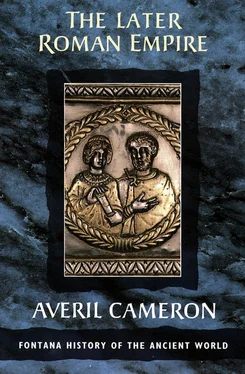he did not even allow poor prostitutes to escape. The result was that as each fourth year came round when this tax had to be paid, weeping and wailing were heard throughout the city, because beatings and tortures were in store for those who could not pay owing to extreme poverty. Indeed mothers sold their children and fathers prostituted their daughters under compulsion to pay the exactors of the chrysargyron . (Zos. II.38, writing after the tax had been abolished in AD 499)
The recent reforms were still working themselves through during the reign of Constantine, and if there was some sense of recovery, it was doubtless partly because the changes then introduced were now gradually being felt. The wars of Constantine’s early years also eventually gave way to his sole rule, which in itself brought respite and consolidation. One way however in which he seems at first sight to have dramatically departed from Diocletian’s precedent is in his use of senators in high office. According to Eusebius ( VC IV. 1), Constantine greatly expanded the senatorial order, bestowing senatorial rank without the obligation to reside in Rome and attend meetings of the Senate itself. Later, a second Senate was founded at Constantinople, which had to be filled largely by new appointments. The role played by the new senators was however significantly different from that of senators in the early empire (see Chapter I). Interestingly, in view of their eclipse during the third century, Constantine used members of the great Roman families in his administration, as senatorial governors ( consulares ), as correctores , governors of provinces in Italy, as prefects of the city of Rome, and in the now largely honorific office of consul. Emulating their early imperial predecessors, these men were proud to record their offices on inscriptions, though the offices themselves were often different. The consul of AD 337, the year of Constantine’s death, was Fabius Titianus, who had been corrector of Flaminia and Picenum, consularis of Sicily, proconsul of Asia, comes primi ordinis (in Constantine’s comitatus ), and was prefect of the city from AD 339–41 ( ILS 1227, see Barnes, New Empire , 109). One of the consuls of AD 335 was Ceionius Rufius Albinus, son of Rufius Volusianus, who was himself consul in 311 and 314; the son survived exile for magic and adultery by Constantine in the fateful year 326 to become consularis of Campania, proconsul of Achaea and Asia, consul and prefect of the city (Barnes, New Empire , 108; for his father’s career, see 100).
This development gives the lie, incidentally, to the commonly held theory of estrangement between Constantine and the Roman Senate. It would be natural to suppose that Constantine surrounded himself with Christians, but few of his appointees, to these posts at least, are provably Christian. An exception is the famous Ablabius (cos. AD 331), a Cretan of humble birth who came to Constantine’s attention, rose to become praetorian prefect and had the honour of having his daughter betrothed to the emperor’s son Constans (see Barnes, New Empire , 104); but most were from the new aristocracy which emerged in Rome out of the third-century confusion. Constantine’s expansion of the senatorial order was extremely important; it was to provide the foundation of a further enlargement over the next two centuries, in the course of which the equestrian order effectively disappeared. But it can be seen as supplying a need rather than as an act of deliberate social policy, and it seems less of a reversal of Diocletianic policy when it is recognized that the latter had no provable animus against senators as such; nor is it likely that it was part of a deliberate effort by Constantine directed at conciliating the still-pagan Roman aristocracy.
Constantine’s legislation continued the tendencies already apparent under Diocletian, by further restricting the freedom of movement of decurions and coloni . The financial burdens on the former were considerable, as is clear from the difficulties Constantine had in enforcing his law exempting Christian clergy from service on the town councils (Euseb., Church History X.7) – their disgruntled fellow-townsmen, with their own burdens correspondingly increased, kept trying to enrol them and had to be repeatedly restrained. Ironically, Constantine also found himself legislating to control the numbers of those who now flocked to be ordained and gain these privileges for themselves; ordination was to be permitted only when a member of the clergy died, or if there was a vacancy for other reasons. Coloni too were forbidden to leave their estates; landlords harbouring such runaways must give them up, and if those whose coloni had left succeeded in recovering them, they were allowed to keep them in chains as if they were actually slaves ( CTh . V. 17.1, AD 332).
Even in the religious sphere, Constantine was following good precedent in claiming to be under special divine protection; it is very possible that he initially saw the Christian God in the same light as Apollo and Sol Invictus, as a protector who would grant favours in return for his own attachment. At any rate, he continued to put Sol on his coins until as late as AD 320–1, although in his letter of AD 313 exempting Christian clergy from curial responsibilities he clearly identifies the maintenance of Christianity with the good of the empire, saying that by being so relieved of fiscal demands, they will
be completely free to serve their own law [i.e. Christianity] at all times. In thus rendering service to the deity, it is evident that they will be making an immense contribution to the welfare of the community. (Euseb., Church History
Конец ознакомительного фрагмента.
Текст предоставлен ООО «ЛитРес».
Прочитайте эту книгу целиком, купив полную легальную версию на ЛитРес.
Безопасно оплатить книгу можно банковской картой Visa, MasterCard, Maestro, со счета мобильного телефона, с платежного терминала, в салоне МТС или Связной, через PayPal, WebMoney, Яндекс.Деньги, QIWI Кошелек, бонусными картами или другим удобным Вам способом.












